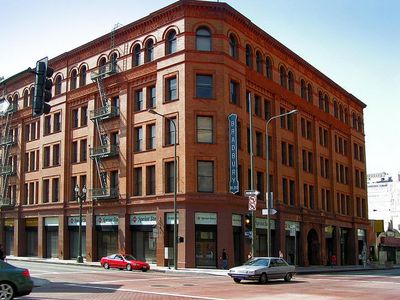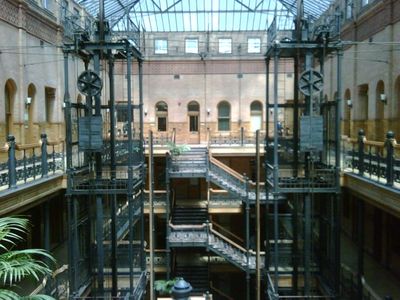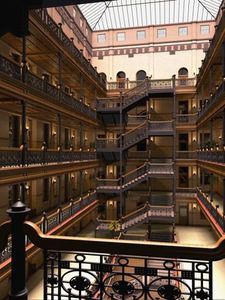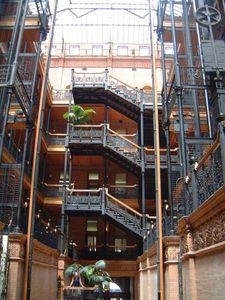Bradbury Building
The Bradbury Building is an architectural landmark in Los Angeles, California. The building was built in 1893 and is located at 304 South Broadway (at 3rd Street) in downtown.
History
The building was commissioned by Lewis L. Bradbury (✦November 6, 1823 †July 15, 1892), for whom it is named. Bradbury was a mining millionaire (he owned a gold mine named Tajo in Sinaloa, Mexico) who became a real estate developer in the latter part of his life. He planned in 1892 to construct a five-story building at Broadway and Third Street in Los Angeles, close to the Bunker Hill neighborhood.
A local architect, Sumner Hunt, was first hired to complete a design for the building, but Bradbury dismissed Hunt's plans as inadequate to the grandeur of his vision. He then hired George Wyman, one of Hunt's draftsmen, to design the building.
At first Wyman refused the offer, but then supposedly had a ghostly talk with his brother Mark Wyman (who had died six years previously), while using a planchette board with his wife. The ghost's message supposedly said, "Mark Wyman / take the / Bradbury building / and you will be / successful" with the word "successful" written upside down. After the episode, Wyman took the job and is now regarded as the architect of the Bradbury Building. Wyman's grandson, the science fiction publisher Forrest J. Ackerman, owned the original document containing the message until his death. Coincidentally, Ackerman was a close friend of science fiction author Ray Bradbury.
Wyman was especially influenced in constructing the building by the 1887 science fiction book "Looking Backward" by Edward Bellamy, which described a utopian society in 2000.
In Bellamy's book, the average commercial building was described as a "vast hall full of light, received not alone from the windows on all sides, but from the dome, the point of which was a hundred feet above ... The walls and ceiling were frescoed in mellow tints, calculated to soften without absorbing the light which flooded the interior." This description greatly influenced the Bradbury Building.
A restoration and seismic retrofitting by developer Ira Yellin and project architect Brenda Levin Associates was undertaken in 1991. As part of the restoration, a storage area at the south end of the building was converted to a new rear entrance portico, connecting the building more directly to Biddy Mason Park and the adjacent Broadway Spring Center parking garage. The building's lighting system was also redesigned, bringing in alabaster wall sconces from Spain.
Building today
The building has operated as an office building for most of its history. It was designated a National Historic Landmark in 1977.
From 2001 to 2003, A+D Museum: Los Angeles had its home in the building.
Today the building serves as headquarters for the Los Angeles Police Department's Internal Affairs division and other government agencies. Several of the offices are rented out to private concerns, including Red Line Tours. The retail spaces on the first floor currently house Ross Cutlery, a Subway sandwich restaurant, a Sprint cell phone store, and a real estate sales office for loft conversions in other nearby historic buildings.
Appearance in popular media
The Bradbury Building is featured prominently as the setting in a wide range of popular media -- particularly in the science fiction genre -- including films, television, literature, and music videos. Most notably, the building is the setting for both the climactic rooftop scene of the 1982 cult classic Blade Runner, as well as the set of the character J. F. Sebastian's apartment in which much of the film's story unfolds.
The Bradbury also featured in the 1944 Billy Wilder film classic Double Indemnity and the 1950 film noir classic D.O.A. (including the final shootout). It appeared prominently in the 1953 film noir , "The Jury. Joseph Losey's 1951 remake of M starring David Wayne, contains a long search sequence filmed in the building, and a spectacular shot through the roof's skylight. The famed 5-story atrium also substituted for the interior of the seedy skid-row hotel depicted in the climax of the Jack Lemmon comedy Good Neighbor Sam (1964), supposedly set in San Francisco but filmed, save for some establishing shots and rear-projection footage, entirely in Los Angeles.
The Bradbury also featured in the 1994 film Wolf (starring Jack Nicholson), the Charles Bronson movie Murphy's Law (1986), Chinatown ('1974), Lethal Weapon 4 (1998), Marlowe (1969), Avenging Angel (1985), as well as The Indestructible Man (1956), the 1972 made-for-television movie The Night Strangler, and the Michael Douglas and Demi Moore vehicle, Disclosure (1994). In (500) Days of Summer (2009) the building features in the last scenes as the location of an architectural firm.
Television series that featured the building include the 1964 Harlan Ellison written episode Demon with a Glass Hand for The Outer Limits. During the Season Six episodes (1963-64) of the series 77 Sunset Strip, Stuart "Stu" Bailey (Efrem Zimbalist Jr., the only remaining recurring cast member) had his office in the Bradbury. In Quantum Leap the building is seen carrying the name "Gotham Towers" in //Play it again, Seymour, the last episode of the first season (1989). The building appeared in at least one episode in each of the following television series: "Banyon" (1972-73), "City of Angels" (1976), "Mission: Impossible" (1966-73), as well as in the "Ned and Chuck's Apartment" episode of "Pushing Daisies", which debuted in 2007. The building was also the setting for a scene from the series "FlashForward" in the episode "Let No Man Put Asunder". In 2010 the building was transplanted to NYC for a 2 part episode of "CSI NY." The Bradbury Building and a fake New York City subway entrance across the street were also used to represent the exterior of New York's High School for the Performing Arts in the opening credits of the television series "Fame."
The Bradbury appeared in music videos from the 1980s by Heart, Janet Jackson, Earth Wind and Fire and Genesis, and a Pontiac Pursuit commercial. Part of Janet Jackson's 1989 film short Janet Jackson's Rhythm Nation 1814 was filmed in the building as well. The interior appears in the music video for the Pointer Sisters' 1980 song, "He's So Shy".
The building featured in the photography on the Microsoft Office SharePoint Portal Server 2003 box, while the personal computer game SimCity 3000 shows the building as one of many being built in the so-called Dense Commercial zones.
The Bradbury has been frequently alluded to in popular literature. In "Gravity's Rainbow" by Thomas Pynchon, the protagonist refers to Philip Marlowe, who will "feel homesick for the lacework balconies of the Bradbury Building." In the Star Trek novel "The Case of the Colonist's Corpse: A Sam Cogley Mystery", the novel's main character works from the Bradbury Building, set four hundred years in the future. Other allusions occur in "The Man With The Golden Torch" by Simon R. Green, and the science fiction multiple novel series "The World Of Tiers" by Philip Jose Farmer.
DC Comics and Marvel Comics (which maintains offices in the real Bradbury Building) both published comics series based on characters that work from the historic landmark. The building serves as the headquarters for the Marvel Comics team The Order. In the DC universe, the "Human Target" runs his private investigation agency from the building.
In popular culture
The Bradbury Building made a memorable place in film history as the insurance office central to the 1944 film noir classic Double Indemnity. It has subsequently been featured prominently as a setting in many films, television shows and in literature—particularly in the science fiction genre. Most notably, the building is a setting in the 1982 science fiction film Blade Runner, for the character J. F. Sebastian's apartment, and the climactic rooftop scene.
The Bradbury Building appeared in the noir films The Unfaithful (1947), Shockproof (1949), D.O.A. (1950) and I, The Jury (1953) (the latter filmed in 3-D). M (1951), a remake of M (1931), contains a long search sequence filmed in the building, and a notable shot through the roof's skylight. The five-story atrium is also substituted for the interior of the seedy skid row hotel depicted in the climax of Good Neighbor Sam (1964).
The building is also featured in China Girl (1942), The White Cliffs of Dover (1944), Indestructible Man (1956), Caprice (1967), Marlowe (1969), the 1972 made-for-television movie The Night Strangler , Chinatown (1974), The Cheap Detective (1978), Avenging Angel (1985), Murphy's Law (1986), The Dreamer of Oz (1990), 1994's Wolf and Disclosure (1994 film), Lethal Weapon 4 (1998), Pay It Forward (2000), What Women Want (2000), (500) Days of Summer (2009) and The Artist (2011).
Television series that featured the building include the 1964 The Outer Limits episode "Demon with a Glass Hand", and the 1962 Perry Mason episode "The Case of the Double-Entry Mind". During the season six episodes (1963–64) of the series 77 Sunset Strip, the Stuart "Stu" Bailey character had his office in the Bradbury. In Quantum Leap the building is seen carrying the name "Gotham Towers" in "Quantum Leap episode "Play It Again, Seymour", the last episode of the first season (1989). The building appeared in at least one episode of the television series Banyon (1972–73), where it was used as Robert Forster's office, City of Angels (1976 TV series) and Mission: Impossible (1966 TV series)|Mission: Impossible (1966–73), as well as Ned and Chuck's Apartment in Pushing Daisies, which debuted in 2007. The building was also the setting for a scene from the series FlashForward in the episode "Let No Man Put Asunder". In 2010 the building was transplanted to New York City for a two-part episode of CSI: NY. The Bradbury Building and a fake New York City subway entrance across the street were also used to represent the exterior of New York's High School for the Performing Arts in the opening credits of the television series Fame (1982 TV series)|Fame. The building appears as itself in multiple episodes of the fourth season of Amazon Studios' original series Bosch (TV series)|Bosch, in both exterior establishing shots and interior shots.
The Bradbury appeared in a 1979 music video for "Take Me Home" by Cher, in addition to music videos from the 1980s by Heart (band)|Heart, Janet Jackson, Earth Wind and Fire and Genesis, and a Pontiac Pursuit commercial. Part of Janet Jackson's 1989 film short Janet Jackson's Rhythm Nation 1814 was filmed in the building as well. The interior appears in the music video for the Pointer Sisters' 1980 song, "He's So Shy". The Bradbury Building was prominently featured in Monica's 1998 single "The First Night" as well in Tony! Toni! Toné!'s "Let's Get Down" music video. In 2016, the interiors were featured in the music video for "The Road" by Chinese musician Huang Zitao.
The Bradbury has frequently appeared in popular literature. In the "Nathan Heller" series of detective novels by Max Allan Collins, Heller's A-1 Detective Agency's Los Angeles offices are housed in the Bradbury, as shown in the novel Angel in Black. In the Star Trek novel The Case of the Colonist's Corpse: A Sam Cogley Mystery, the protagonist works from the Bradbury Building four hundred years in the future. Other appearances occur in The Man With The Golden Torc by Simon R. Green, Angels Flight and The Black Box by Michael Connelly, and the science-fiction multiple novel series The World of Tiers by Philip Jose Farmer.
DC Comics and Marvel Comics—the latter of which has offices in the real Bradbury Building—both published comic book series based on characters that work in the historic landmark. The building serves as the headquarters for the Marvel Comics team The Order (comics)|The Order, and in the DC Universe, the Human Target runs his private investigation agency from the building.
The building was used for the music video for "Say Something (Justin Timberlake song)|Say Something", a song released on January 25, 2018 by Justin Timberlake featuring Chris Stapleton.
The Bradbury Building was featured in "On Location", episode 172 of the podcast 99% Invisible. The building interior was shown in the title sequence for the TV series The Ray Bradbury Theater, which aired from 1985 to 1992.
Chat rooms • What links here • Copyright info • Contact information • Category:Root



